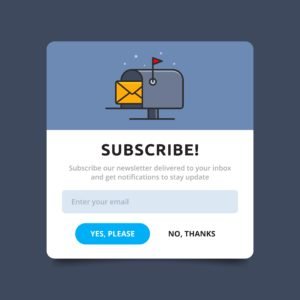About The Nude Window
The Nude Window is a Sunshine Coast-based family business specialising in bespoke curtains and blinds for homes, builders, wholesalers and interior designers. Since starting in 2019, they’ve built a local...
Email marketing is a form of marketing where you communicate with your clients, potential clients and past clients via email. As technology has progressed, the strategy behind marketing via email has grown exponentially. Traditionally, emails would be sent from clients (such as Outlook or Gmail) one by one or with a whole list in your 'To' field.
Nowadays, platforms such as Mailchimp, Hubspot and Campaign Monitor, make it easy to send emails to an entire list or a single person based on a set of criteria. However, with the ease of sending, comes the possibility of seeming like spam to your audience. Despite this, email marketing is seen as an effective way to spread your message - your subscribers should have knowingly signed up to your list - therefore they are a highly engaged audience. It is essential to ensure the content you are sending is relevant and exciting to your audience, so that they continue to stay subscribed.
There are several different ways you can use email marketing for your business. Email marketing can be used as an effective lead nurture tool via automation as well as a fantastic method to keep your audience up-to-date with what's happening in your business. Some ideas of the kind of content you can include are below:
Welcome to new clients
Offers and promotions
New product or service announcements
Upcoming events
New blog content
Business news
Monthly newsletters
It is imperative to adhere to email marketing best practices to get the most out of your marketing activity. As a marketing consultant, I cannot stress enough how important it is to grow your list healthily. Ensure your subscribers know they have subscribed - this can be through an email form that is explicitly signing up to your email list or adding a check-box to other website forms that outline that by ticking the box they are subscribing to your email list.
You must not purchase a third-party list, and often, email platforms such as Mailchimp prohibit you from uploading these lists. Why? You ask. Generally speaking, emails sent to people who have not requested to receive your emails do not have a good open rate, and users report the messages as Spam. These outcomes negatively affect the overall deliverability of your campaigns.
It is also essential to send relevant information to your audience. The more relevant the content, the more likely they are to read your emails and recommend that their friends, family and colleagues also read them.
You will also need to figure out how often you should be emailing your audience. You need to communicate with your customers enough to ensure you are staying connected, however, not so regularly that they get sick of seeing you in their inbox.
Personalisation is only as good as your data. Inputting someone's first name into the email is an obvious way to personalise the email, however, if you know other things such as where they are based geographically, you can customise the messaging and the content to be relevant. How often have you received an email from an American-based company and they are talking about it being Winter when in Australia it is Summer?
An easy way to personise your emails is to effectively use segmentation so that you can deliver relevant information. Examples of how you can segment your email list include demographics (age, gender, geography), past purchases or service use, type of customer and how long they have been a customer. Most email platforms make it easy to add segments to your list based on criteria.
When you have new customers sign up for your product or service, you can ask them to subscribe to your newsletter at the same time.
Alternatively, to grow your list organically you can:
offer content so interesting that your audience wants to read it as it is published.
offer discounts - online stores use this strategy a lot! You would have noticed pop-ups offering you a 10% discount when someone subscribes to the list.
special offers - as a retail business you could offer free shipping if someone signs up, as a service-based business you could consider free installation or training.
Run a competition - make sure you abide by any competition rules in your State or Territory. QLD, NSW, VIC, SA

Lorem ipsum dolor sit amet consectetur, adipisicing elit. Ipsa libero labore natus atque, ducimus sed.

Small Business, Hospitality, Tips, Customer Experience
Marketing isn’t just about products, services, or clever advertising - it’s about people.
People buy from people.
The strength of relationships in business is what truly drives long-term success, and one of the best examples of...